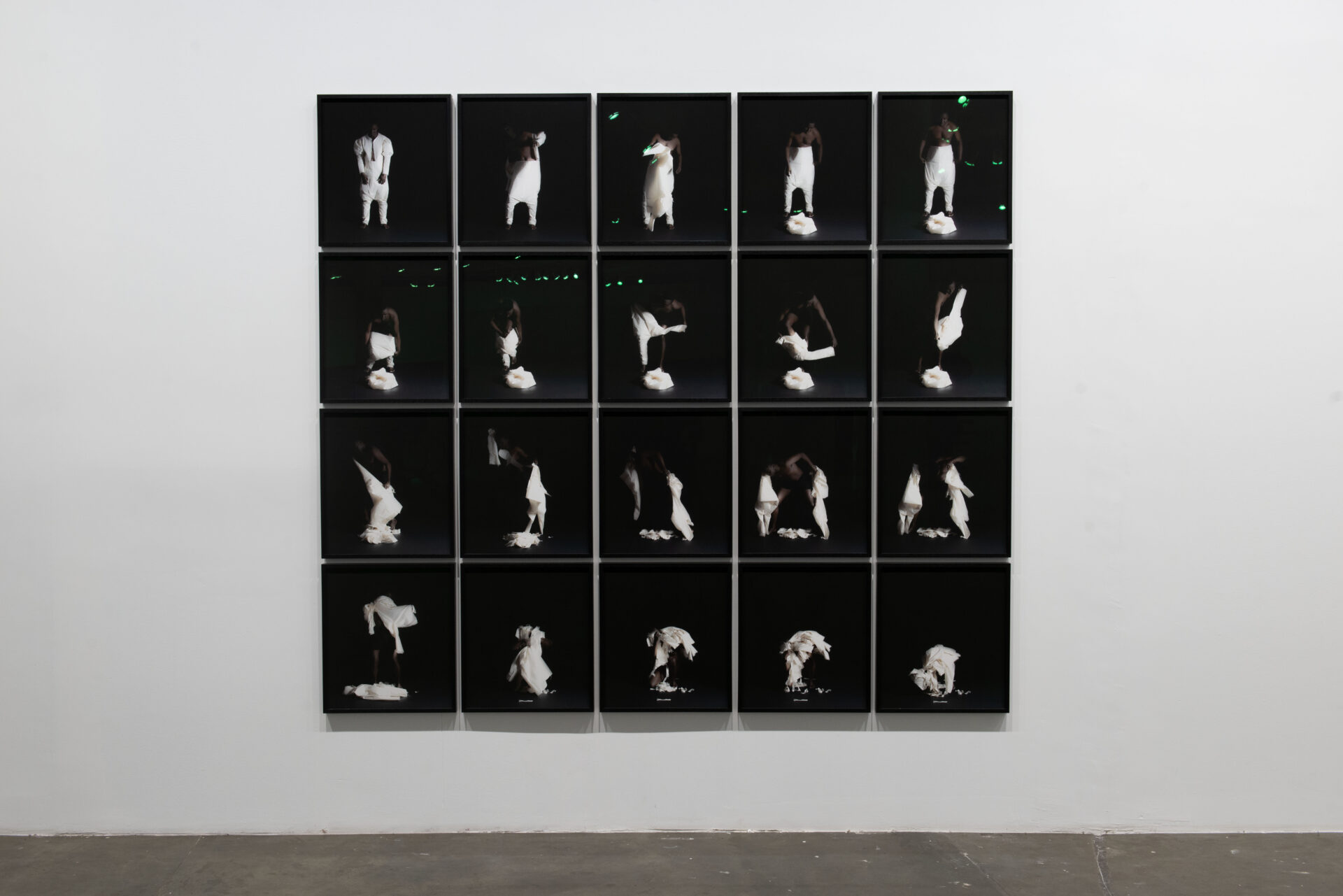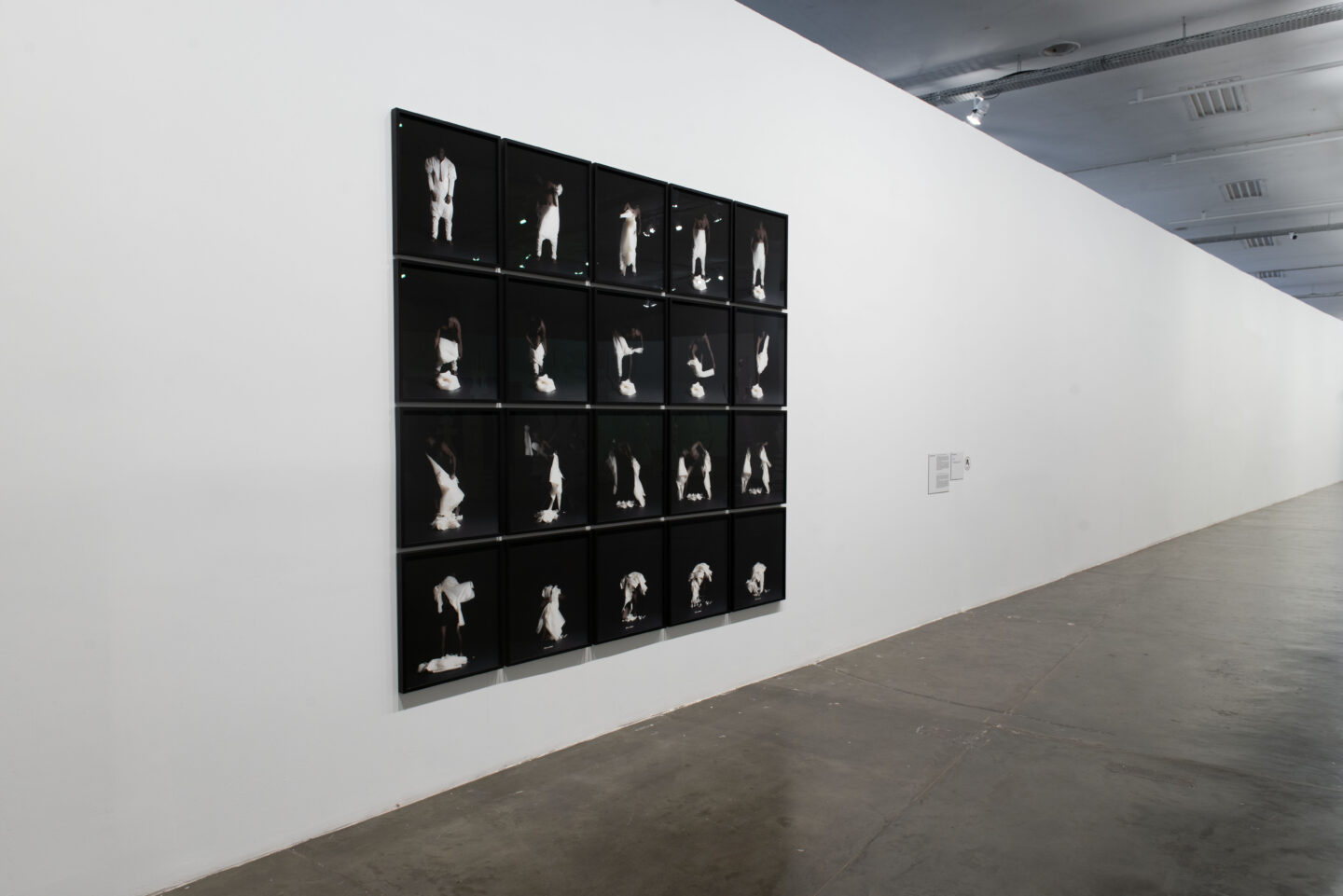
Januário Jano
In the photographic installation Baptism (2019), we observe a set of twenty photographs showing Januário Jano taking off white clothes. The exuberance of the image of the whole draws attention. However, in the research of the materials, any disinterested contemplation is dissolved: the white clothes are memories of the civilizing impositions of the Portuguese colonizers on Angolans. The fabric, 100% cotton, refers to the fields of Baixa do Cassange, where the massacre that ignited the struggle for Angola’s liberation took place in 1961. This dimension of violence – especially the response to it – emerges from a craftsmanship that understands research not as a stage to reach a product, but as the living matter to which the gaze must constantly return when it is willing to propose other worlds.
Video, sculpture, painting, photography, installation, sewing, or interdisciplinary art, if you will. The repertoire of languages that Jano uses to put his ideas into practice is vast, as is vast and unsettling the range of forces that underlie all artistic making as a consequence of history and culture. There are many media, layers, and themes that are in friction when considering the complexities of the field of cultural identities, a terrain in which he operates to instigate debate. From Luanda, in Portuguese, but also from the land of the Ambundu, in Kimbundu – Bantu language – or in English from London, where he trained and settled. The artist’s own biographical transits highlight the marks of colonization, a central theme in his work; also for this reason, it is before himself – the mirror, his history – that Jano finds the raw material that occasionally escapes his own life and ends up echoing in the words of his fellow country-woman: “surviving our history is akin to surviving in an unforgiving city” – said Djaimilia Pereira de Almeida, as he might have said himself. ¹
Igor De Albuquerque, translated from Portuguese by Philip Somervell
1. Djaimilia Pereira de Almeida, “Morrer de Nostalgia” in Revista Quatro cinco um, São Paulo, jun. 2023, p. 8.
- Vista da obra Baptism [Batismo], de Januário Jano durante a 35ª Bienal de São Paulo – coreografias do impossível © Levi Fanan / Fundação Bienal de São Paulo
- Vista da obra Baptism [Batismo], de Januário Jano durante a 35ª Bienal de São Paulo – coreografias do impossível © Levi Fanan / Fundação Bienal de São Paulo
- Vista da obra Baptism [Batismo], de Januário Jano durante a 35ª Bienal de São Paulo – coreografias do impossível © Levi Fanan / Fundação Bienal de São Paulo
- Vista da obra Baptism [Batismo], de Januário Jano durante a 35ª Bienal de São Paulo – coreografias do impossível © Levi Fanan / Fundação Bienal de São Paulo
Januário Jano (Luanda, Angola, 1979. Lives between Luanda and Lisbon, Portugal) is a multidisciplinary visual artist with interests in sculpture, textiles and performing arts, video, and photography. Jano founded the Cultural Collective Pés Descalços and has been organizing TEDxLuanda since 2012. To produce his work, Jano uses textiles, fabric, and other materials to display ideas such as worldly topics, economics, and politics. Some of his other interests include the relationships between fiction and reality and human and non-human co-existance. He was awarded the LAGUNA ART PRIZE and has recently been nominated for The Norval Sovereign African Art Prize. His work can be found in prominent collections such as Victoria and Albert Museum (London, UK), The Marino Golinelli Collection (Italy), Taguchi Art Collection (Japan), Damian Grieder Collection (Switzerland), Economic Bank of Angola, Banco de Fomento de Angola Collection, and Portuguese National Archive.

 Português
Português


